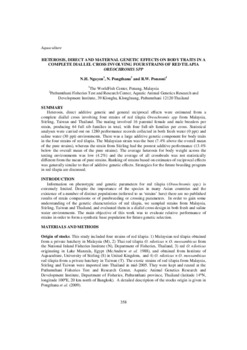Heterosis, direct and maternal genetic effects on body traits in a complete diallel cross involving four strains of red tilapia Oreochromis spp

Citation
Nguyen, N.H.; Pongthana, N.; Ponzoni, R.W. (2009). Heterosis, direct and maternal genetic effects on body traits in a complete diallel cross involving four strains of red tilapia Oreochromis spp. Proceedings of the 18th Conference of the Association for the Advancement of Animal Breeding and Genetics. 28 Sept-1 Oct 2009, Brossa Valley, South Australia. 18:358-361
Heterosis, direct additive genetic and general reciprocal effects were estimated from a complete diallel cross involving four strains of red tilapia Oreochromis spp from Malaysia, Stirling, Taiwan and Thailand. The mating involved 16 parental female and male breeders per strain, producing 64 full sib families in total, with four full-sib families per cross. Statistical analyses were carried out on 1280 performance records collected in both fresh water (0 ppt) and saline water (30 ppt) environments. There was a large additive genetic component for body traits in the four strains of red tilapia. The Malaysian strain was the best (7.4% above the overall mean of the pure strains), whereas the strain from Stirling had the poorest additive performance (13.4% below the overall mean of the pure strains). The average heterosis for body weight across the testing environments was low (4.2%) and the average of all crossbreds was not statistically different from the mean of pure strains. Ranking of strains based on estimates of reciprocal effects was generally similar to that of additive genetic effects. Strategies for the future breeding program in red tilapia are discussed.
Permalink
Date Available
Type
Research Themes
Topics
Language